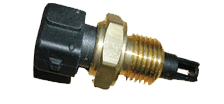









| FAQ #204 | |
  |
|
 |
Temperature sensor |
 |
What it does temperature sensitive variable resistor converts temperature into an electrical reading that the ECU can use to calculate the engine’s ignition/fuel system requirements. temperature sensitive variable resistor converts temperature into an electrical reading that the ECU can use to calculate the engine’s ignition/fuel system requirements.How it works: For the most part, temperature sensors in motor vehicle applications are linear NTC (negative temperature coefficient) resistors. The resistance of the sensor will reduce in direct relationship to an increase in temperature. Some manufacturers (such as Renault) use PTC coolant sensors in which the resistance increases with an increase in temperature. The vast majority of sensors used in automotive applications are of the direct contact type, where the sensing element is in direct contact with the medium being measured, as opposed to non-contact infra-red type sensors. Reasons for failure/testing: Automotive temperature sensors operate on low voltages (generally 5v) and in harsh environments. The low voltage input suffers from even the slightest increase in resistance due to, for example, corroded connectors, poor earths, etc. This is especially relevant with engine mounted coolant sensors that are constantly subjected to vibration, moisture and extreme temperature swings. A visual inspection can highlight many failures. There are three areas that should be checked when testing a temperature sensor. * The supply voltage * The resistance of the sensor * The signal to the ECU  supply voltage should be checked with an accurate voltmeter at the sensor itself. It is important that it is checked “under load”, that is with the sensor connected, as this will show up most poor connection faults. Compare the voltage to known data sources. Check for both over and under voltage conditions, a short to 12v is quite a common problem. supply voltage should be checked with an accurate voltmeter at the sensor itself. It is important that it is checked “under load”, that is with the sensor connected, as this will show up most poor connection faults. Compare the voltage to known data sources. Check for both over and under voltage conditions, a short to 12v is quite a common problem.Check the condition of the sensor by measuring its resistance and measuring the temperature and compare the readings to known data sources. This test is accurate but is a test of the sensor only. Checking the return voltage at the ECU will highlight connection or loom faults between the actual sensor and the ECU. Once again a temperature reading will have to be taken and compared to known data sources. It is possible to test the sensor off the car by carrying out a resistance check as above and, using the water temperature sensor as an example, submerge the tip of the sensor into a vessel of hot water, collate the water temperature and resistance readings and compare them to your data source. With an air temperature sensor do not submerge into water, use hot air to vary the temperature. Note: If using a code reader as your primary test equipment, beware as the information it supplies can be misleading. If a vehicle is suffering from an overheating problem caused by a blocked radiator, the temperature sensor will be reporting a higher than normal temperature reading, one which under normal operating conditions, the ECU will never see. The ECU recognises this as a fault and will more often than not indicate a temperature sensor failure. Not everything is as simple as it first may seem. |
| Views | 3315 (Unique 1975) |
| Member Rating : |           10.0 - 1 vote 10.0 - 1 vote |
| FAQ Posted by | C6Dave |
| Info | Created: 07 October 2009 Last Updated: 18 December 2015 |